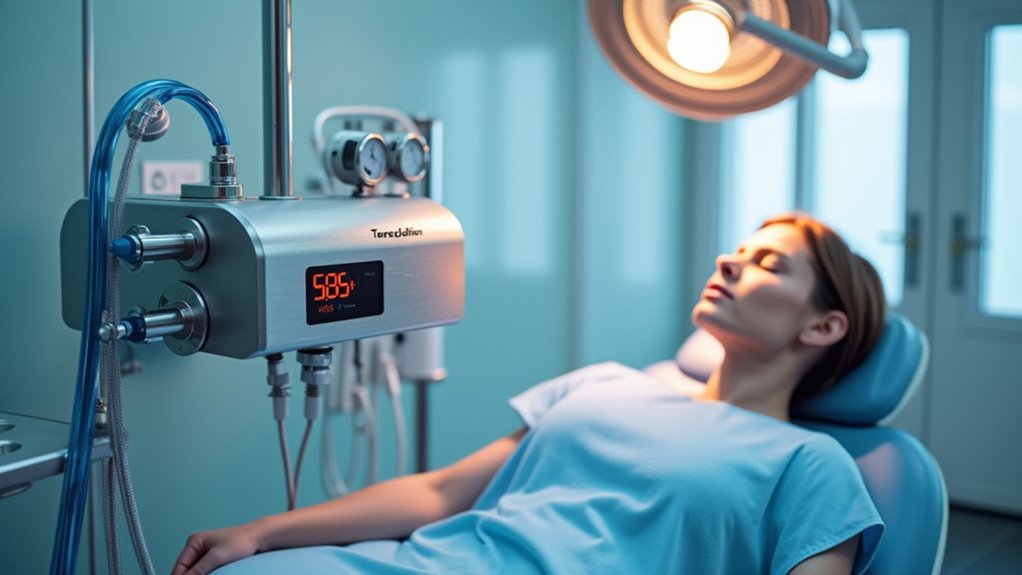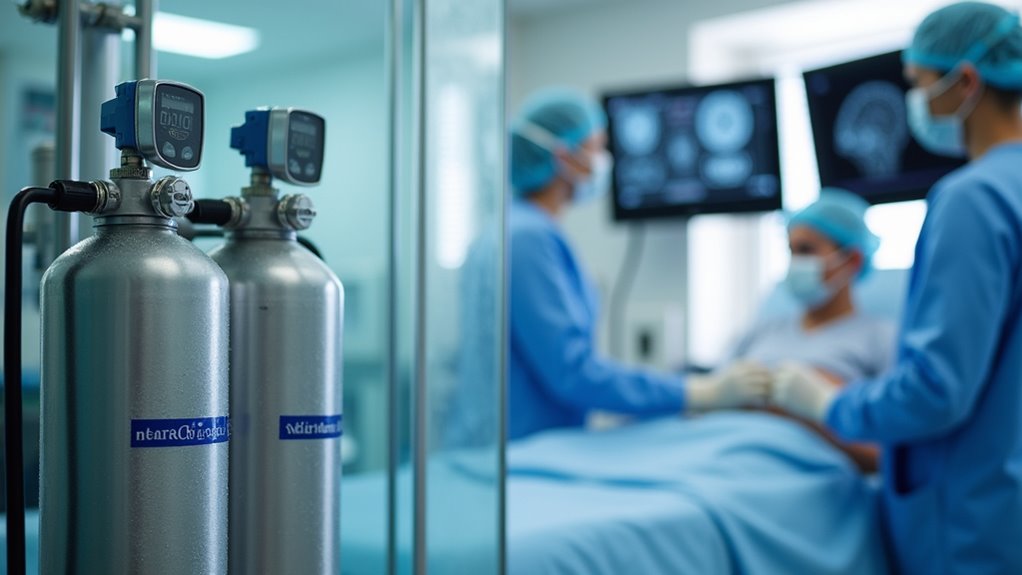Recent clinical trials show you’ll find nitrous oxide amplifying far beyond traditional anesthesia roles. N2O now demonstrates significant therapeutic potential in pain management, mental health treatment, and neuroprotection. You can achieve 45% pain reduction within 5 minutes through NMDA receptor modulation, while 50% N2O mixtures show promise for treatment-resistant depression. Cost-effective protocols, rapid recovery times, and improved safety profiles make this versatile agent increasingly valuable across multiple medical disciplines. The latest research reveals even more groundbreaking applications.
Advancing Pain Management Through N2O Therapy

While traditional pain management approaches have shown limitations, nitrous oxide (N2O) therapy demonstrates promising advances across multiple clinical applications. You’ll find that N2O’s rapid onset delivers a 45% pain reduction within just 5 minutes for acute trauma patients, primarily through NMDA receptor modulation. Researchers at the University of Chicago are examining 50% nitrous oxide for treating fibromyalgia pain.
Clinical trials reveal N2O’s versatility in both emergency and procedural settings. You can achieve acute analgesia augmentation using a 65% nitrous oxide/oxygen mixture, which proves especially effective during photodynamic therapy and minimally invasive procedures. The treatment’s non-invasive nature and favorable safety profile make it an attractive alternative to opioid-based interventions. Current research at Cleveland Clinic is evaluating nitrous oxide treatment in a 44-patient randomized trial.
For conditions like CRPS and fibromyalgia, N2O targets overactive NMDA receptors, addressing the underlying mechanisms of pain amplification while potentially offering sustained relief through novel therapeutic pathways.
Mental Health Breakthroughs: Beyond Traditional Treatments

Recent breakthroughs in nitrous oxide applications have revolutionized mental health treatment protocols, particularly for treatment-resistant major depression (TRMD). Clinical trials demonstrate significant therapeutic benefits using 50% nitrous oxide mixtures during one-hour sessions, achieving 20% response rates in patients who’ve failed multiple antidepressant regimens. This anesthesia-free sedation approach activates specific L5 neurons in the prefrontal cortex, enhancing cognitive flexibility treatment outcomes. Layer 5 pyramidal neurons become more active when exposed to nitrous oxide, reversing stress-induced suppression. The drug blocks specialized potassium channels to reactivate neural circuits dulled by depression.
You’ll find nitrous oxide’s rapid-acting properties especially valuable, as symptom improvement occurs within hours rather than weeks. Unlike traditional antidepressants, this intervention requires single sessions and works through non-monoaminergic pathways. A lower 25% nitrous oxide dose proved nearly as effective while eliminating adverse effects like nausea. Current research investigates extended therapeutic effects, biomarker development, and combination therapies, positioning nitrous oxide as a pioneering solution for TRMD and acute postpartum depression management.
Neuroprotective Properties in Critical Care Medicine

You’ll find that nitrous oxide’s neuroprotective mechanisms in critical care settings operate through multiple pathways, including NMDA receptor antagonism and cerebral blood flow regulation to minimize secondary injury cascades.
During acute brain injuries and strokes, you can harness nitrous oxide’s ability to modulate cerebral metabolism and neurotransmitter balance, providing essential protection during the critical treatment window. Research shows that administering 50 percent concentration offers complete neuroprotection when given within 2 hours of an ischemic event. Studies indicate that increased NO metabolites in cerebrospinal fluid correlate with greater brain injury severity. Due to its recreational abuse potential, there has been a concerning rise in ED presentations highlighting significant public health risks.
The metabolic protection pathways you’ll observe include homocysteine-mediated effects and reduced oxygen demand, though you must carefully monitor B12 levels to prevent potential neurotoxicity during extended use.
Brain Injury Recovery Mechanisms
Despite its long-standing use as an anesthetic, nitrous oxide demonstrates significant neuroprotective properties through multiple cellular mechanisms in brain injury recovery. You’ll find its primary action centers on NMDA receptor antagonism, blocking glutamate-mediated excitotoxicity and regulating calcium influx at critical cellular junctions. Modern studies validate these findings through real-time PCR analysis of glutamate receptor expression patterns.
The agent’s effectiveness shows marked age-dependent considerations, requiring careful dosing adjustments in both pediatric and elderly populations. You’ll need to maintain concentrations at 50% volume for ideal neuroprotection while avoiding potential neurotoxicity. The drug’s mechanism includes homocysteine modulation and nitric oxide inhibition, which you can monitor through biomarker surveillance. Clinical studies indicate that treatment must be initiated within 2 hours after the onset of brain ischemia for optimal outcomes.
When you’re treating brain injuries, nitrous oxide’s ability to reduce oligodendrocyte damage and regulate glutamate levels becomes particularly valuable, though you’ll need to supplement with vitamin B12 to manage homocysteine elevation.
Stroke Treatment Potential
Emerging evidence demonstrates nitrous oxide’s significant potential as a neuroprotective agent in acute stroke management, particularly during critical renewal periods. Research shows that endoplasmic reticulum stress plays a key role in stroke-related neuronal injury. You’ll find it’s especially effective as an adjunctive therapy during acute stroke intervention, modulating glutamate release and reducing oxidative stress in affected tissues. Full neuroprotection was observed in rats when nitrous oxide was administered at 50% volume within 2 hours of ischemia onset.
When administered during thrombolysis, N2O shows promise in improving thrombolysis outcomes through multiple mechanisms. It targets penumbral regions while facilitating vasodilation, helping preserve metabolically active brain tissue. The dual role of nitric oxide in both neuroprotection and neurotoxicity makes precise timing crucial for optimal therapeutic benefits. You’ll need to ponder precise dosing regimens, as N2O’s protective effects are concentration-dependent. While clinical data remains limited, preclinical studies demonstrate reduced infarct volumes and improved neurological outcomes, particularly when combined with other neuroprotective strategies. Future applications may include targeted delivery systems and biomarker-driven protocols to optimize therapeutic efficacy.
Metabolic Protection Pathways
Nitrous oxide’s neuroprotective mechanisms extend beyond stroke treatment into broader metabolic pathways, with NMDA receptor antagonism serving as a primary protective mechanism in crucial care settings. You’ll find its bioenergetic regulation impacts cellular signaling pathways through controlled NMDA blockade, reducing excitotoxicity while maintaining essential neuronal functions. Recent studies demonstrate that cerebral blood flow significantly decreases during therapeutic intervention, yet paradoxically contributes to improved oxygen balance in affected tissues.
| Pathway | Protection Mechanism | Clinical Management |
|---|---|---|
| NMDA Antagonism | Reduces Ca2+ influx | Monitor exposure time |
| B12 Metabolism | Prevents myelin damage | B12 supplementation |
| Cellular Defense | Anti-apoptotic effects | Track biomarkers |
When you’re implementing N2O therapy, you’ll need to maintain precise B12 levels to optimize neuroprotection while preventing metabolic complications. The key lies in balancing NMDA receptor modulation with careful monitoring of homocysteine levels, ensuring maximum protective benefits in crucial care scenarios.
Revolutionizing Procedural Sedation Protocols
Nitrous oxide’s emergence as a game-changing procedural sedation agent centers on three key innovations: rapid recovery times averaging 3-5 minutes, cost reductions of up to 40% compared to traditional sedatives, and an enhanced safety profile with minimal respiratory depression.
You’ll find the versatility of N2O particularly valuable in outpatient procedures, where quick turnaround times and reduced monitoring requirements streamline clinical workflows. Hands-on training with inhalation equipment in clinical settings ensures practitioners develop essential proficiency in administration techniques.
The implementation of modern nitrous oxide delivery systems, equipped with precise flow controls and real-time monitoring capabilities, has established new benchmarks for procedural sedation safety while maintaining ideal patient comfort and procedural effectiveness.
Rapid Recovery Advantages
Numerous medical facilities have revolutionized their procedural sedation protocols by leveraging nitrous oxide’s rapid recovery profile. You’ll experience optimized pain relief within minutes of administration, while maintaining cognitive clarity throughout the procedure. The medication’s swift onset and offset characteristics enable precise control over sedation depth, facilitating accelerated discharge timelines.
After treatment, you’ll notice minimal post-procedural disruption, as nitrous oxide allows you to regain motor skills quickly without the lingering drowsiness common to traditional sedatives. You won’t encounter typical side effects like nausea or dizziness, and there’s no risk of withdrawal symptoms. This efficient recovery profile makes nitrous oxide particularly valuable for outpatient procedures, letting you return to daily activities sooner while ensuring your safety and comfort throughout the medical intervention.
Cost-Effective Sedation Solutions
Beyond its rapid recovery benefits, modern healthcare facilities are uncovering significant economic advantages in nitrous oxide-based sedation protocols. You’ll find cost savings emerge when success rates exceed 59%, particularly when integrating N2O into ambulatory settings. The protocol reduces reliance on expensive inhalational anesthetics while enabling shorter procedure durations.
The facility can optimize resource utilization through portable delivery systems and streamlined staffing requirements. At concentrations ≤50%, you’re achieving minimal sedation sufficient for many procedures while maintaining patient satisfaction outcomes. The versatility across pediatric procedures, from dental work to imaging, makes it particularly cost-effective in high-volume settings. You’ll notice reduced post-procedure supervision time and fewer repeated procedures, though you must balance these benefits against training requirements and population-specific monitoring needs.
Enhanced Safety Profile
Modern safety protocols have revolutionized nitrous oxide administration through integrated monitoring systems and precise concentration controls. You’ll find these advancements mitigating occupational exposure while maintaining ideal patient safety through automated delivery systems and digital tracking devices.
Critical safety measures include:
- Maintaining nitrous oxide concentrations ≤70% with oxygen blending ratios ≥30%
- Implementing NIOSH-recommended ventilation controls to keep exposure below 25 ppm
- Optimizing equipment maintenance through regular calibration and safety checks
You’re protected by comprehensive monitoring systems that track crucial signs and gas concentrations in real-time. With automated alarms alerting you to any deviations, you can focus on procedure execution while the integrated safety features confirm both patient and provider protection.
These protocols enhance procedural efficiency while maintaining strict safety standards.
Emerging Applications in Regenerative Medicine
Nitrous oxide’s groundbreaking role in regenerative medicine represents a significant advancement in cellular therapy and tissue engineering. Through stem cell engineering, you’ll find amplified survival pathways and improved migration capacity, while biomaterials optimization delivers controlled release mechanisms for therapeutic concentrations.
You can now achieve remarkable clinical outcomes across multiple applications. In skin aging treatments, you’ll see improvements in texture and tone, while wound healing cases show resolution of non-healing ulcers within 30-45 days. The technology’s impact extends to acne treatment, where you’ll observe up to 84% reduction in pustules and nodules.
When combined with specialized delivery systems, you’ll notice increased cell survival rates in damaged tissues and augmented integration with surrounding structures, leading to accelerated revascularization and improved healing outcomes.
Modern Veterinary Medicine: N2O Integration
While traditional anesthetic protocols remain foundational, N2O integration has revolutionized veterinary medicine through bolstered safety profiles and optimized procedural outcomes. You’ll find veterinary anesthetic considerations have evolved to incorporate N2O as an indispensable adjunct, particularly in canine procedures where rapid induction and recovery are paramount.
Key dosage optimization strategies include:
- Co-administration with isoflurane/sevoflurane for accelerated induction speed
- Weight-based adjustments for small-to-medium dogs
- Precision delivery through modern gas systems
You can harness N2O’s rapid elimination properties for same-day discharges, while its compatibility with volatile agents supports balanced anesthesia protocols. When combined with oxygenated recovery methods, you’ll achieve faster post-operative stabilization and reduced dysphoria risk, making it particularly valuable in high-risk or compromised patients.
Cost-Effectiveness and Healthcare Economics
As healthcare systems worldwide seek cost-effective anesthetic solutions, N₂O has emerged as a financially advantageous choice in clinical settings. You’ll find that N₂O’s rapid induction and recovery times directly contribute to budget optimization strategies, enabling higher patient throughput and reduced operational costs.
Healthcare system efficiencies are enhanced through N₂O’s standardized flow rates of 1-1.5 L/min, while novel technologies like Medclair’s gas capture systems help offset environmental compliance costs. The market’s projected growth to $2.37 billion by 2025 reflects N₂O’s sustained cost-effectiveness across multiple applications.
You’ll see particularly strong returns in specialized fields such as dermatology, cryosurgery, and emergency medical services, where N₂O’s immediate effects reduce staffing requirements and minimize recovery monitoring costs. This operational efficiency translates to significant time and resource savings in clinical practice.
Safety Profiles and Clinical Best Practices
Beyond its cost advantages, the safety profile of N₂O demands rigorous adherence to established clinical protocols. You’ll find its perioperative risk minimization attributes particularly compelling, with reduced cardiovascular depression and lower hypotension risks compared to other anesthetics.
For ideal occupational hazard mitigation, you must implement:
- NIOSH-compliant ventilation systems maintaining exposure below 25 ppm
- Mandatory pre-procedure oxygenation protocols and post-procedure 100% O₂ recovery
- Continuous monitoring via audio/visual safety alerts and pressure sensors
This anesthetic’s safety record is especially remarkable in pediatric applications, where studies of 1,019 patients demonstrated no severe adverse events. While contraindicated in pulmonary hypertension, N₂O shows no significant nephro or hepatotoxicity and doesn’t trigger malignant hyperthermia, making it a reliable choice for many clinical scenarios.
Frequently Asked Questions
How Does Nitrous Oxide Interact With Common Psychiatric Medications?
You’ll need to monitor medication half-life interactions carefully when using nitrous oxide with psychiatric drugs. It can amplify sedation with benzodiazepines and antipsychotics, potentially requiring adjusted anesthetic dose requirements.
While it doesn’t substantially interact with SSRIs, you should watch for B12 depletion that might affect drug metabolism. You’ll need to be especially cautious with CNS depressants, as N2O can intensify respiratory depression and drowsiness effects.
Can Patients Develop Tolerance to Nitrous Oxide Over Repeated Treatments?
Yes, you can develop tolerance to nitrous oxide through both acute and chronic mechanisms. During a single session, you’ll notice acute tolerance affecting pain thresholds within 40 minutes, though detection thresholds remain stable.
The absorption and elimination kinetics over time don’t typically lead to sustained chronic tolerance between properly spaced sessions. However, you should monitor for potential cross-tolerance with other anesthetics if you’re receiving multiple treatments. Individual responses vary notably.
What Dietary Restrictions Should Patients Follow Before Nitrous Oxide Administration?
You’ll find that dietary restrictions before nitrous oxide are less strict than other sedation methods. While fasting duration before administration isn’t typically mandatory, you should follow your provider’s specific guidelines.
It’s best to avoid heavy meals 2-3 hours before the procedure, and maintain normal dietary protein intake until then. You can usually consume clear liquids up to 2 hours pre-procedure, but avoid dairy products and alcohol 24 hours beforehand.
Does Genetic Variation Affect Individual Response to Nitrous Oxide Therapy?
Yes, your response to nitrous oxide can vary based on genetic factors. Individual metabolic factors, particularly variants in NOS3 and GUCY1A3 genes, may influence how effectively you process the gas. You may have a genetic predisposition to side effects based on these variations.
Your healthcare provider should consider genetic screening if you’ve had adverse reactions to nitrous oxide previously or have a family history of unusual responses to anesthetic gases.
How Do Altitude Changes Impact Nitrous Oxide Delivery and Effectiveness?
When you administer nitrous oxide at higher altitudes, you’ll notice significant altitude-induced changes in its effectiveness. The reduced atmospheric pressure decreases N₂O’s partial pressure, diminishing its analgesic potency.
Above 3,300m, you’ll need to adjust ideal delivery protocols since standard 50% concentrations become less effective. You should consider increasing N₂O concentrations or adding adjunct medications to maintain therapeutic benefit.
Always calculate delivered partial pressures based on your facility’s altitude.

